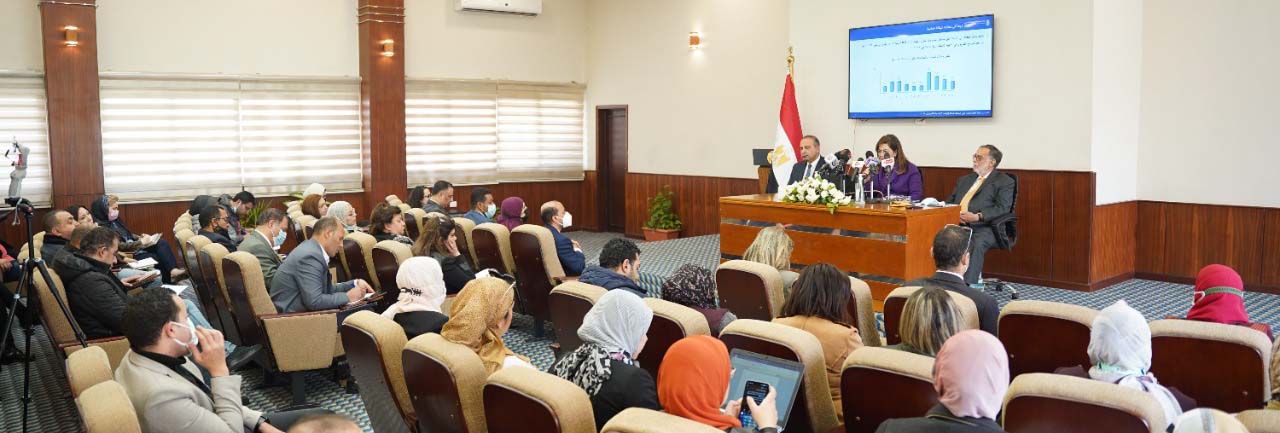During the press conference held by the Ministry of Planning and Economic Development:- H.E. Dr. Hala El-Said , Egypt’s Minister of Planning & Economic Development reviews the indicators for Q2 of the current fiscal year.

22 February 2022
El-Said announces an increase in GDP estimates during the period 2016/2017 - 2020/2021
The Egyptian economy witnessed an improvement in economic performance, achieving a growth rate of 8.3% during Q2 of the current fiscal year: Says Hala El-Said
The growth rate is expected to reach 6.2% to 6.5% by the end of this year, exceeding the expectations of international institutions for growth rates during the year: Says Hala El-Said.
GoE considers the implementation of an economic census every three years to maximize the use of the data provided by the census: Says Hala El-Said
Cairo - February 22, 2022
Egypt’s Ministry of Planning and Economic Development held on Tuesday a press conference to review the performance indicators of the Egyptian economy during the second quarter (Q2) of the current fiscal year 2021/2022.The efforts of the Ministry of Planning in reviewing and auditing GDP data were also reviewed, in the presence of H.E .Dr. Hala El-Said, Minister of Planning and Economic Development, Dr. Ahmed Kamali, Deputy Minister of Planning, and Dr. Fathi Saqr, the Minister's economic advisor.During the conference, Dr. Hala El-Said reviewed the indicators of the performance of the Egyptian economy during the second quarter of the current fiscal year 2021/2022. El-Said pointed out that the Egyptian economy witnessed an improvement in economic performance, achieving a growth rate of 8.3% during the second quarter of the current fiscal year, compared to a growth rate of 2% during the second quarter of last year. El-Said explained that the growth rate during the first half of the current fiscal year amounted to 9%, adding that the growth rate is expected to reach between 6.2% and 6.5% by the end of this year, to be among the highest growth rates that were expected.El-Said confirmed that all sectors witnessed the positive performance, with the tourism sector recording a growth of 63%, and the telecommunications sector a growth rate of 16.7%, in addition to the Suez Canal sector achieving 13%, and the industry by 10%, as well as 8.5% for the construction sector, with the health sector, achieving 5.7 % growth rate, and education 5.5%. El-Said explained that the agriculture sector for the first time broke the 5% barrier, explaining that the tourism sector achieved 108% during the first half of the current fiscal year, telecommunications 16.5%, and the manufacturing industry 15.5%.Regarding the sectors that contribute the most to the output, El-Said referred to the sectors of manufacturing, trade and retail, agriculture, real estate activities, and extractions.
She pointed out that the unemployment rate decreased to 7.4% during the second quarter, compared to 7.5% during the previous quarter, affected by the drop in male unemployment rates from 5.9 to 5.2%. El-Said continued, referring to the sectors that contributed to the employment rates, which were represented in the agricultural sectors in the first place, then trade and retail, the construction sector, manufacturing industries, transportation, and storage.Dr. Hala El-Said announced an increase in the GDP estimates by 9.2% by the end of the year 2020/2021, in light of the process of reviewing the output data in the framework of the results of the economic census 2017/2018.El-Said explained that the Ministry of Planning and Economic Development has audited the country's GDP data in coordination with the relevant ministries and authorities by conducting a review process for the GDP activities in light of the results of the economic census of establishments for the year 2017/2018. Which was implemented by the Central Agency for Public Mobilization and Statistics and its results were announced in 2020, within the framework of the Egyptian state’s interest in developing the data system on an ongoing basis with a high degree of transparency and accuracy and following international standards in this field.El-Said confirmed that this census is the most comprehensive compared to previous censuses, as it included about 3.7 million establishments, as the census covers establishments operating in all economic activities, including the public/business sector and the formal and informal private sector within the establishments. El-Said indicated that the total number of workers in all the establishments included in the census amounted to about 13.5 million.El-Said said that the review was based not only on economic census data but also on labor force research data to estimate the invisible part of the informal economy outside establishments, according to objective and approved methodologies, issued by relevant international institutions.El-Said added that the review also included an audit of the data of the economic authorities and the general government.El-Said added that the review process, which lasted 16 months, revealed a remarkable increase in the value of the gross domestic product, which amounted to EGP 331 billion in the 2017/2018 census year, as the value of the output reached 4.8 trillion pounds, compared to EGP 4.4 trillion before the review process, an increase of 7.5%.El-Said indicated that the construction activity acquired the largest share of the value of the increase in output in 2017/2018 by about EGP 121 billion of the total increase in output, i.e. by more than a third of the increase in the adjusted value of output, in light of the remarkable boom that the sector witnessed as a result of projects Nationalism implemented by the state in the field of housing and roads.
El-Said indicated the sectoral distribution of the relative increase in output, explaining that most of the increase came in the construction and building sectors by 37%, followed by the industry sector by 18%, education and health by 9.4%, and other social services by 8.8%, real estate activities and business services by 8.8% and the sector Transportation and storage by 6% and electricity by 4%.El-Said added that these sectors contributed about 92% of the value of the increase in output in 2017/2018.El-Said explained that the 2017/2018 census contributed the largest share in adjusting the value of the output, especially with the development of the methodology used, compared to the 2012/2013 economic census. El-Said added that the current results of this census were better, more accurate, and more comprehensive compared to previous censuses.El-Said reviewed a number of the most important results of the review, noting that the contribution of the informal sector amounted to only 30% of the GDP, in addition to the contribution of the formal private sector by 34% of the GDP, in addition to the contribution of the public sector by 36% of the GDP.El-Said explained that the efforts to audit the accounts of the domestic product are a continuous process based on the application of the best international practices and methodologies in calculating the output and filling the data gaps using the latest technical and technological means and making full use of the field surveys carried out by the Central Agency for Public Mobilization and Statistics (CAPMAS). El-Said pointed out that these efforts are expected to result in another stage of the review and audit process by the end of this year, adding that the completion of the automation process for some sectors such as taxes, customs, and the commercial registry is also expected to contribute to the audit of the output data.









